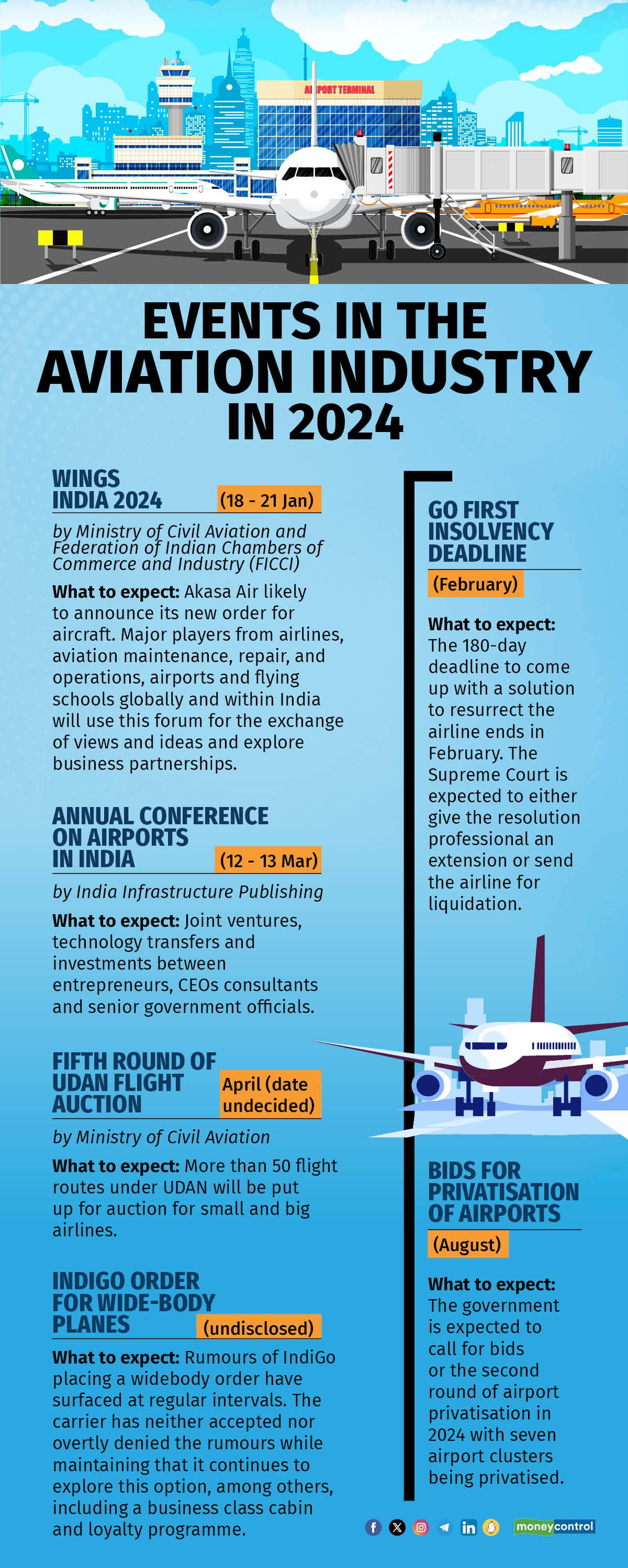



The calender year of 2023 saw air traffic returning to pre-COVID levels and the Indian airline industry turning into a duopoly of sorts, with Indigo and Air India claiming over 80 percent of the market (Indigo: 60.3 percent; Air India Group: 26 percent). The new year will see competition intensifying even as the sector works towards improving its overall health and turning profitable in 2024.
On a macro level, geopolitical factors, the upcoming general election, and any potential impact of COVID-19 variants on travel will be key factors to watch out for.
Closer home, the insolvency plan of the Wadia group-promoted Go First will be closely tracked — Jet Airways hasn’t managed to resume operations despite a rescue plan.
Customers will also be hoping for improved service quality in 2024 after around 88 percent of Indian passengers said that domestic airlines had been cutting corners for the last two years, noting that the quality of service provided and safety standards had gone down since the pandemic.
 Aviation events planned in 2024 so far.
Aviation events planned in 2024 so far.
Here are the top things to watch out for in the aviation sector in 2024:
Aircraft Capacity: With the collapse of Go First, alongside IndiGo, Air India and SpiceJet grounding around 160 aircraft till December 2023, there was a capacity constraint in the Indian aviation market last year.
This constraint is likely to continue in 2024, with another 35 of IndiGo’s aircraft likely to be grounded in the quarter ending March, due to ongoing issues with the Pratt & Whitney engines that are used in Airbus A320 and 321 aircraft.
With 135 planes running on such engines, IndiGo will have to ground all these planes over the next two years to undergo safety inspections.
This is expected to result in a capacity constraint, leading to more flight cancellations and delays and a “crisis situation”, said Kapil Kaul, chief executive and director of CAPA India, an aviation consultancy and research firm.
New Orders and Airports: Air India and IndiGo announced that they are likely to take delivery of one aircraft every week in 2024.
Akasa Air is expected to announce a three-digit aircraft order in January, with speculation rife that the order is likely to be announced at Wings India 2024.
IndiGo is also expected to place an order for around 30 widebody aircraft in 2024 as it looks to expand its international operations.
Around 15 new airports, including the Noida International Airport in Jewar and DB Patil International Airport in Navi Mumbai, are expected to be inaugurated in 2024.
New Aviation Policy: The government is also working to come out with a new national policy to transform Indian airports into major international hubs that will offer single-point international connectivity to the South Asian region.
In 2023, CAPA India called for a new long-term aviation policy in the backdrop of the aviation landscape witnessing rapid changes in the post-Covid period.
The government is also expected to announce new bilateral flying agreements in the second half of 2024.
“Extending the freeze beyond that will possibly exacerbate aero-political and trade tensions,” CAPA India said, adding that foreign carriers are seeking an additional 150,000 seats per week in the near term. However, it expects any liberalisation to be gradual.
Autonomous Safety Body: A large section of the aviation industry has also called for a new autonomous body to regulate aviation safety in India.
Last year, the Directorate General of Civil Aviation (DGCA) first faced criticism that it was slow to act in the Air India ‘pee-gate’ incident, Go First then blamed it for not intervening when its planes got grounded. Eyeballs were raised once again after the sudden death of an IndiGo pilot. Since October, allegations of corruption have swirled around the DGCA.
While the DGCA has intervened in most of the aforementioned issues and addressed them in due course, questions of DGCA officials abusing their power have raised concerns about the sanctity of the regulator’s processes.
Will India adopt an autonomous aviation safety regulator like the Federal Aviation Administration in 2024?
Also Read: 12 things to look forward to in Indian aviation in 2024
Industry Outlook
Captain Sanjay Mandavia, Chairman of regional carrier FlyBig
To address pilot fatigue, the government should introduce a practical and sensible fatigue risk management system (FRMS).
The new FRMS should have a transparent confidential scheme of fatigue reporting, whereby pilots can report fatigue directly to a specialised nodal office in the DGCA.
Captain Shakti Lumba, former IndiGo VP and head of Alliance Air
The government should harmonise aviation regulations with those of the European Union Aviation Safety Agency.
The DGCA and the Aircraft Accident Investigation Bureau need to be made autonomous, beyond the jurisdiction of the government, in line with the Federal Aviation Administration and the National Transportation Safety Board.
Captain Mohan Ranganathan, a former member of the Civil Aviation Safety Advisory Council
The government needs to launch a revamped Civil Aviation Policy and create an independent professional Civil Aviation Authority.
The centre also needs to increase efforts to address corruption in the sector and expose coverups.
Discover the latest Business News, Sensex, and Nifty updates. Obtain Personal Finance insights, tax queries, and expert opinions on Moneycontrol or download the Moneycontrol App to stay updated!
Find the best of Al News in one place, specially curated for you every weekend.
Stay on top of the latest tech trends and biggest startup news.